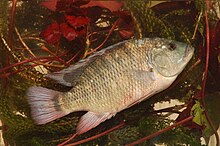The redbreast tilapia (Coptodon rendalli) is a species of fish in the family Cichlidae. It is found widely in the southern half of Africa. Its natural habitats are freshwater lakes and freshwater marshes.[3] It is known as the redbreast kurper in South Africa.[4]
| Redbreast tilapia | |
|---|---|

| |
| Scientific classification | |
| Domain: | Eukaryota |
| Kingdom: | Animalia |
| Phylum: | Chordata |
| Class: | Actinopterygii |
| Order: | Cichliformes |
| Family: | Cichlidae |
| Genus: | Coptodon |
| Species: | C. rendalli
|
| Binomial name | |
| Coptodon rendalli (Boulenger, 1897)
| |
| Synonyms[2] | |
| |
Distribution
editThe species is found in the drainage basins of the upper Congo River and the Kasai River, in Lake Tanganyika, Lake Malawi, Zambezi River, and the coastal regions of the Zambezi outlet to KwaZulu-Natal, as well as in the Limpopo River, the Okavango River, and the Cunene River. They have been established as edible fish in several countries.
Description
editC. rendalli grows to a maximum length of 45 cm and a maximum weight of 2.5 kg, and possesses a high-backed, sideways oblate body. Its body height is 42.2 to 49.4% of its standard length, and its head length is 31.1% to 37.5% of standard length. The top of its head is convex, or sometimes concave in large specimen due to the continued growth of the mouth region. Its mouth is studded with short, wide, thick, two-pointed teeth. Their lower pharyngeal jaw is as wide as it is long. Its toothed back area is longer than its front area. Seven to 10 gill raker streams are located on the lower branch of its first gill arch.
Its head and rump are olive-green on top and paler on the sides. Like all members of the genus Coptodon, its breast and belly are often tinted red. The flanks display a few lateral ligaments. Its olive-green dorsal fin possesses a red rim and white to grey spots on the soft streamed section.
- Fin formula: dorsal XIV–XVII/10–13, anal III/9–10
- Scale formula: SL 28–32, 3–5 rows of scales on the sides of the head
- Vertebrae: 29
Behaviour
editC. rendalli mainly lives near river banks, in oxbow lakes, and swamps. It prefers densely vegetated areas and still waters with small amounts of current. The species has a high temperature tolerance (8 – 41 °C) and also withstands brackish water with a salt content of up to 1.9%. The young fish live on plankton; adults, like all members of the genus Coptodon, are primarily herbivores and eat algae and taller plants, as well as insects and smaller crustaceans.
Classification
editThe species was described in 1897 by Belgian-British ichthyologist George Albert Boulenger as Chromis rendalli, and later classified as a member of the genus Tilapia, subgenus Coptodon. The subgenus Coptodon was elevated to a genus in early 2013.[5] The specific name honours British zoologist Percy Rendall (1861-1948), the collector of the type[6] from the upper Shire River in British Central Africa.[7]
References
edit- ^ Konings, A.; Awaïss, A.; Azeroual, A.; et al. (2019) [amended version of 2018 assessment]. "Coptodon rendalli". IUCN Red List of Threatened Species. 2019: e.T60690A155041001. doi:10.2305/IUCN.UK.2019-3.RLTS.T60690A155041001.en. Retrieved 18 February 2020.
- ^ Froese, Rainer; Pauly, Daniel (eds.). "Coptodon rendalli". FishBase. December 2019 version.
- ^ Konings, A.; Awaïss, A.; Azeroual, A.; Getahun, A.; Hanssens, M.; Lalèyè, P.; Marshall, B.; Moelants, T.; Natakimazi, G.; Tweddle, D. (2019). "Coptodon rendalli". IUCN Red List of Threatened Species. 2019: e.T60690A155041001. doi:10.2305/IUCN.UK.2019-3.RLTS.T60690A155041001.en. Retrieved 11 November 2021.
- ^ Big Bass
- ^ Dunz, Andreas R.; Schliewen, Ulrich K. (July 2013). "Molecular phylogeny and revised classification of the Haplotilapiine Cichlid fishes formerly referred to as "Tilapia"". Molecular Phylogenetics and Evolution. 68 (1): 64–80. doi:10.1016/j.ympev.2013.03.015. PMID 23542002.
- ^ Christopher Scharpf & Kenneth J. Lazara (2 October 2019). "Order CICHLIFORMES: Family CICHLIDAE: Subfamily PSEUDOCRENILABRINAE (a-g)". ETYFish Project Fish Name Etymology Database. Christopher Scharpf and Kenneth J. Lazara. Retrieved 18 February 2020.
- ^ Eschmeyer, William N.; Fricke, Ron & van der Laan, Richard (eds.). "Species in the genus Coptodon". Catalog of Fishes. California Academy of Sciences. Retrieved 18 February 2020.
Further reading
edit- Melanie Stiassny, Guy Teugels & Carl D. Hopkins: The Fresh and Brackish Water Fishes of Lower Guinea, West-Central Africa, Band 1. ISBN 9789074752206[1]
- ^ Poissons d'eaux douces et saumâtres de basse Guinée, ouest de l'Afrique centrale = The fresh and brackish water fishes of Lower Guinea, West-Central Africa. Stiassny, Melanie L. J., Teugels, Guy G., Hopkins, Carl D., American Museum of Natural History. Paris, France: Institut de recherche pour le développement. 2007. ISBN 9782709916202. OCLC 216917073.
{{cite book}}: CS1 maint: others (link)
